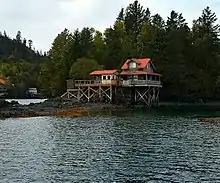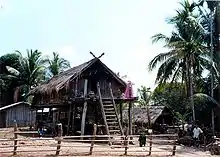Stilt house
Stilt houses are houses raised on stilts over the surface of the soil or a body of water. Stilt houses are built primarily as a protection against flooding;[1] they also keep out vermin.[2] The shady space under the house can be used for work or storage.[3]
Arctic

Houses where permafrost is present, in the Arctic, are built on stilts to keep permafrost under them from melting. Permafrost can be up to 70% water. While frozen, it provides a stable foundation. However, if heat radiating from the bottom of a home melts the permafrost, the home goes out of level and starts sinking into the ground. Other means of keeping the permafrost from melting are available, but raising the home off the ground on stilts is one of the most effective ways.
Indo-Pacific

Raised rectangular houses are one of the cultural hallmarks of the Austronesian peoples and are found throughout the regions in Island Southeast Asia, Island Melanesia, Micronesia, and Polynesia settled by Austronesians. The structures are raised on piles, usually with the space underneath also utilized for storage or domestic animals. The raised design had multiple advantages, they mitigate damage during flooding and (in very tall examples) can act as defensive structures during conflicts. The house posts are also distinctively capped with larger-diameter discs at the top, to prevent vermin and pests from entering the structures by climbing them. Austronesian houses and other structures are usually built in wetlands and alongside bodies of water, but can also be built in the highlands or even directly on shallow water.[5][4][6][7]

Building structures on pilings is believed to be derived from the design of raised rice granaries and storehouses, which are highly important status symbols among the ancestrally rice-cultivating Austronesians.[4][7] The rice granary shrine was also the archetypal religious building among Austronesian cultures and was used to store carvings of ancestor spirits and local deities.[7] While rice cultivation wasn't among the technologies carried into Remote Oceania, raised storehouses still survived. The pataka of the Māori people is an example. The largest pataka are elaborately adorned with carvings and are often the tallest buildings in the Māori pā. These were used to store implements, weapons, ships, and other valuables; while smaller pataka were used to store provisions. A special type of pataka supported by a single tall post also had ritual importance and were used to isolate high-born children during their training for leadership.[4]
The majority of Austronesian structures are not permanent. They are made from perishable materials like wood, bamboo, plant fiber, and leaves. Because of this, archaeological records of prehistoric Austronesian structures are usually limited to traces of house posts, with no way of determining the original building plans.[8] Indirect evidence of traditional Austronesian architecture, however, can be gleaned from their contemporary representations in art, like in friezes on the walls of later Hindu-Buddhist stone temples (like in reliefs in Borobudur and Prambanan). But these are limited to the recent centuries. They can also be reconstructed linguistically from shared terms for architectural elements, like ridge-poles, thatch, rafters, house posts, hearth, notched log ladders, storage racks, public buildings, and so on. Linguistic evidence also makes it clear that stilt houses were already present among Austronesian groups since at least the Late Neolithic.[6][7]
Arbi et al. (2013) have also noted the striking similarities between Austronesian architecture and Japanese traditional raised architecture (shinmei-zukuri). Particularly the buildings of the Ise Grand Shrine, which contrast with the pit-houses typical of the Neolithic Yayoi period. They propose significant Neolithic contact between the people of southern Japan and Austronesians or pre-Austronesians that occurred prior to the spread of Han Chinese cultural influence to the islands.[6] Rice cultivation is also believed to have been introduced to Japan from a para-Austronesian group from coastal eastern China.[9] Waterson (2009) has also argued that the architectural tradition of stilt houses in eastern Asia and the Pacific is originally Austronesian, and that similar building traditions in Japan and mainland Asia (notably among Kra-Dai and Austroasiatic-speaking groups) correspond to contacts with a prehistoric Austronesian network.[7][10]
Americas

Stilt houses were also built by Amerindians in pre-Columbian times. Palafitos are especially widespread along the banks of the tropical river valleys of South America, notably the Amazon and Orinoco river systems. Stilt houses were such a prevalent feature along the shores of Lake Maracaibo that Amerigo Vespucci was inspired to name the region "Venezuela" (little Venice). As the costs of hurricane damage increase, more and more houses along the Gulf Coast are being built as or converted to stilt houses.[11]
Stilt houses are also still common in parts of the Mosquito Coast in northeastern Nicaragua, northern Brazil,[12]
Africa
Stilted granaries are also a common feature in West Africa, e.g., in the Malinke language regions of Mali and Guinea.
Europe


In the Neolithic and the Bronze Age, stilt-house settlements were common in the Alpine and Pianura Padana (Terramare) regions.[13] Remains have been found at the Ljubljana Marshes in Slovenia and at the Mondsee and Attersee lakes in Upper Austria, for example. Early archaeologists like Ferdinand Keller thought they formed artificial islands, much like the Irish and Scottish crannogs, but today it is clear that the majority of settlements were located on the shores of lakes and were only inundated later on.[14] Reconstructed stilt houses are shown in open-air museums in Unteruhldingen and Zürich (Pfahlbauland). In June 2011, the prehistoric pile dwellings in six Alpine states were designated as UNESCO World Heritage Sites. A single Scandinavian pile dwelling, the Alvastra stilt houses, has been excavated in Sweden. Herodotus has described in his Histories the dwellings of the "lake-dwellers" in Paeonia and how those were constructed.[15]
In the Alps, similar buildings, known as raccards, are still in use as granaries. In England, granaries are placed on staddle stones, similar to stilts, to prevent mice and rats getting to the grain.
In Italy there are several stilt-houses settlements, for example the one on the Rocca di Manerba del Garda (Lombardy).
Types
- Diaojiaolou – Stilt houses in southern China.
- Heliotrope – A concept house designed by Rolf Disch with a single stilt, optimized for harnessing solar power.
- Kelong – Built primarily for fishing, but often doubling up as offshore dwellings in the following countries: Philippines, Malaysia, Indonesia and Singapore.
- Bahay Kubo – The traditional house type prevalent in the Philippines.
- Palafito – Found throughout South America since Pre-Columbian times. In the late 19th century, numerous palafitos were built in Chilean cities such as Castro, Chonchi, and other towns in the Chiloé Archipelago, and are now considered a typical element of Chilotan architecture.
- Pang uk – A special kind of house found in Tai O, Lantau, Hong Kong, mainly built by Tankas.
- Papua New Guinea stilt house – A kind of stilt house constructed by Motuans, commonly found in the southern coastal area of PNG.
- Queenslander – Stilt house common in Queensland and northern New South Wales, Australia.
- Sang Ghar – A type of stilt house built in Assam state of India. It is mainly found in flood-prone areas of the Brahmaputra river valley.
- Thai stilt house – A kind of house often built on freshwater, e.g., a lotus pond.
- Vietnamese stilt house – Similar to the Thai ones, except having a front door with a smaller height for religious reasons.
Gallery
 Māori pataka storehouses
Māori pataka storehouses Lacustrine Village found in Lake Zurich, Switzerland
Lacustrine Village found in Lake Zurich, Switzerland Rumoh Aceh, Acehnese traditional house
Rumoh Aceh, Acehnese traditional house Stilt houses in Cempa, located in the Lingga Islands of Indonesia
Stilt houses in Cempa, located in the Lingga Islands of Indonesia A stilt house in Attapeu Province, southern Laos
A stilt house in Attapeu Province, southern Laos Stilt houses along Puget Sound in Fragaria, Washington, United States
Stilt houses along Puget Sound in Fragaria, Washington, United States A rural stilt house in Cambodia
A rural stilt house in Cambodia Bajau stilt houses over the sea in the Philippines
Bajau stilt houses over the sea in the Philippines A stilt house in Southern Thailand
A stilt house in Southern Thailand An African home reconstructed in Germany
An African home reconstructed in Germany A bridge between stilt houses (palafito) in Colombia, in Ciénaga Grande de Santa Marta
A bridge between stilt houses (palafito) in Colombia, in Ciénaga Grande de Santa Marta Traditional stilt house in the Missolonghi Lagoon, Western Greece
Traditional stilt house in the Missolonghi Lagoon, Western Greece Stilt houses on Tonlé Sap Lake, Cambodia
Stilt houses on Tonlé Sap Lake, Cambodia Vacation resort in the Maldives
Vacation resort in the Maldives The biggest stilt house in Vietnam
The biggest stilt house in Vietnam
See also
- Pfahlbaumuseum Unteruhldingen – an English-language article about the stilt house museum in Unteruhldingen, Germany
- Pit-house
- Post in ground
- Prehistoric pile dwellings around the Alps
- Rumah Melayu
- Stiltsville
- Treehouse
- Venice
- Wood pilings
References
- Bush, David M. (June 2004). Living with Florida's Atlantic beaches: Coastal hazards from Amelia Island to Key West. Duke University Press. pp. 263–264. ISBN 978-0-8223-3289-3. Retrieved 27 March 2011.
- Our Experts. Our Living World 5. Ratna Sagar. p. 63. ISBN 978-81-8332-295-9. Retrieved 27 March 2011.
- Cambodian Heritage Camp yearbook.
- Sato, Koji (1991). "Menghuni Lumbung: Beberapa Pertimbangan Mengenai Asal-Usul Konstruksi Rumah Panggung di Kepulauan Pasifik". Antropologi Indonesia. 49: 31–47.
- Paul Rainbird (14 June 2004). The archaeology of Micronesia. Cambridge University Press. pp. 92–98. ISBN 978-0-521-65630-6. Retrieved 27 March 2011.
- Arbi E, Rao SP, Omar S (21 November 2013). "Austronesian Architectural Heritage and the Grand Shrines at Ise, Japan". Journal of Asian and African Studies. 50 (1): 7–24. doi:10.1177/0021909613510245. S2CID 145591097.
- bin Tajudeen I (2017). "Śāstric and Austronesian Comparative Perspectives: Parallel Frameworks on Indic Architectural and Cultural Translations among Western Malayo-Polynesian Societies". In Acri A, Blench R, Landmann A (eds.). Spirits and Ships: Cultural Transfers in Early Monsoon Asia. ISEAS – Yusof Ishak Institute. ISBN 9789814762762.
- Lico, Gerard (2008). Arkitekturang Filipino: A History of Architecture and Urbanism in the Philippines. University of the Philippines Press. ISBN 9789715425797.
- Robbeets M (2017). "Austronesian influence and Transeurasian ancestry in Japanese". Language Dynamics and Change. 7 (2): 210–251. doi:10.1163/22105832-00702005.
- Waterson, Roxana (2009). Paths and Rivers: Sa'dan Toraja Society in Transformation. KITLV Press. ISBN 9789004253858.
- "Fortified Home Design Pioneered on the Texas Gulf Coast". Texasgulfcoastonline.com. Retrieved 2012-08-01.
- Dindy Robinson (15 August 1996). World cultures through art activities. Libraries Unlimited. pp. 64–65. ISBN 978-1-56308-271-9. Retrieved 27 March 2011.
- Alan W. Ertl (15 August 2008). Toward an Understanding of Europe: A Political Economic Précis of Continental Integration. Universal-Publishers. p. 308. ISBN 978-1-59942-983-0. Retrieved 28 March 2011.
- Francesco Menotti (2004). Living on the lake in prehistoric Europe: 150 years of lake-dwelling research. Psychology Press. pp. 22–25. ISBN 978-0-415-31720-7. Retrieved 29 March 2011.
- Herodotus, Histories, 5.16
External links
| Wikimedia Commons has media related to Stilt houses. |
